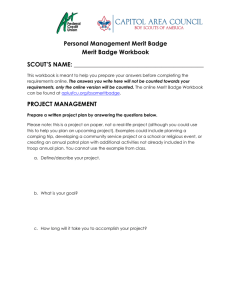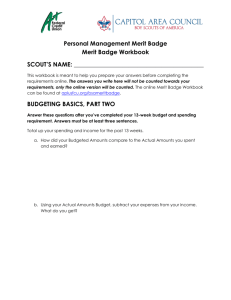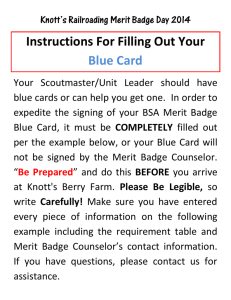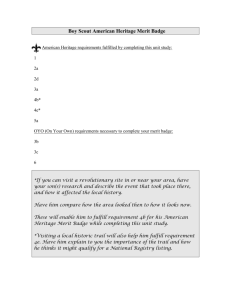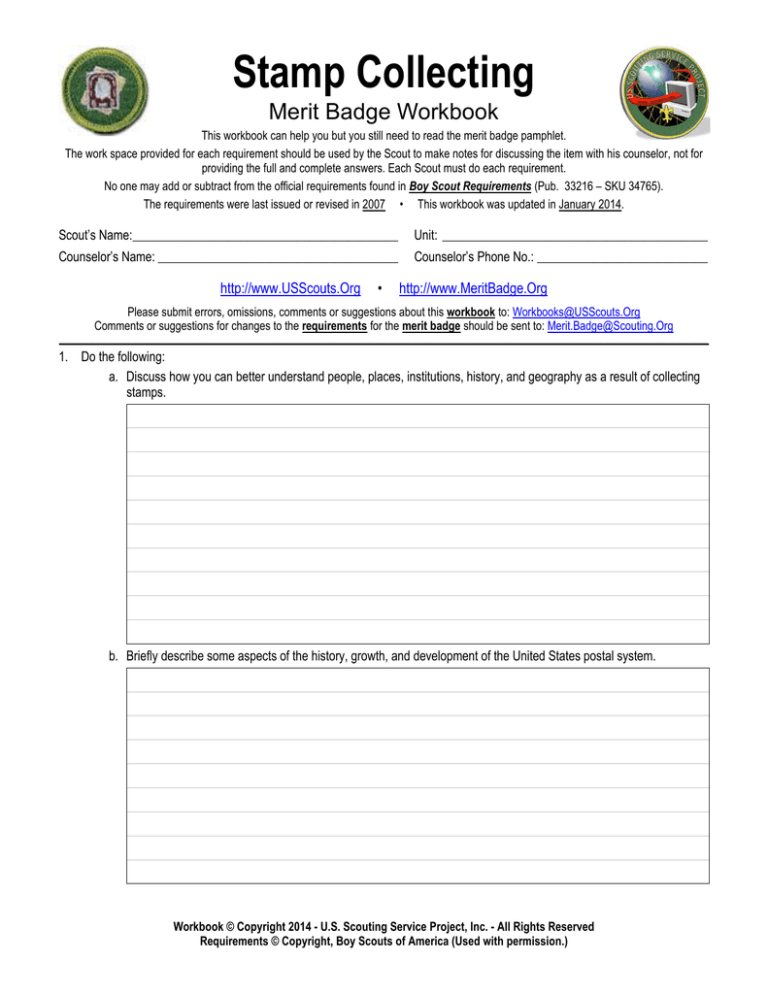
Stamp Collecting
Merit Badge Workbook
This workbook can help you but you still need to read the merit badge pamphlet.
The work space provided for each requirement should be used by the Scout to make notes for discussing the item with his counselor, not for
providing the full and complete answers. Each Scout must do each requirement.
No one may add or subtract from the official requirements found in Boy Scout Requirements (Pub. 33216 – SKU 34765).
The requirements were last issued or revised in 2007 • This workbook was updated in January 2014.
Scout’s Name:__________________________________________
Unit: __________________________________________
Counselor’s Name: ______________________________________
Counselor’s Phone No.: ___________________________
http://www.USScouts.Org
•
http://www.MeritBadge.Org
Please submit errors, omissions, comments or suggestions about this workbook to: Workbooks@USScouts.Org
Comments or suggestions for changes to the requirements for the merit badge should be sent to: Merit.Badge@Scouting.Org
______________________________________________________________________________________________________________________________________________
1. Do the following:
a. Discuss how you can better understand people, places, institutions, history, and geography as a result of collecting
stamps.
b. Briefly describe some aspects of the history, growth, and development of the United States postal system.
Workbook © Copyright 2014 - U.S. Scouting Service Project, Inc. - All Rights Reserved
Requirements © Copyright, Boy Scouts of America (Used with permission.)
Stamp Collecting
Scout's Name: ________________________
Tell how it is different from postal systems in other countries.
2. Define topical stamp collecting.
Name and describe types of stamp collections.
3. Show at least ONE example of each of the following:
a. Perforated and imperforate stamps
b. Mint and used stamps
c. Sheet-booklet and coil stamps
d. Numbers on plate block, booklet, coil, or marginal markings
e. Overprint and surcharge
f. Metered mail
g. Definitive, commemorative, semipostal, and airmail stamps
h. Cancellation and postmark
i. First day cover
j. Postal stationery (aerogramme, stamped envelope, and postal card)
Stamp Collecting - Merit Badge Workbook
Page. 2 of 7
Stamp Collecting
Scout's Name: ________________________
4. Do the following:
a. Demonstrate the use of ONE standard catalog for several different stamp issues. Explain why catalog value can
vary from the corresponding purchase price.
b. Explain the meaning of the term CONDITION as used to describe a stamp.
Show examples that illustrate the different factors that affect a stamp's value.
5. Demonstrate the use of at least THREE of the following stamp collector's tool:
a. Stamp tongs
b. Water and Tray
c. Magnifiers
d. Hinges and stamp mounts
e. Perforation gauge
f. Glassine envelopes and cover sleeves
g. Watermark fluid
Stamp Collecting - Merit Badge Workbook
Page. 3 of 7
Stamp Collecting
Scout's Name: ________________________
6. Do the following:
a. Show a stamp album and how to mount stamps with or without hinges.
Show at least ONE page that displays several stamps.
b. Discuss at least THREE ways you can help to preserve stamps, covers, and albums in first-class condition.
1.
2.
3.
7. Do at least TWO of the following:
a. Design a stamp, cancellation, or cachet.
Stamp Collecting - Merit Badge Workbook
Page. 4 of 7
Stamp Collecting
Scout's Name: ________________________
b. Visit a post office, stamp club, or stamp show with an experienced collector. Explain what you saw and learned.
Location Visited:
Date:
c. Write a review of an interesting article from a stamp newspaper, magazine, book or Web site (with your parent's
permission)
Stamp Collecting - Merit Badge Workbook
Page. 5 of 7
Stamp Collecting
Scout's Name: ________________________
d. Research and report on a famous stamp-related personality or the history behind a particular stamp.
e. Describe the steps taken to produce a stamp. Include the methods of printing, types of paper, perforation styles,
and how they are gummed.
f. Prepare a two-to-three page display involving stamps. Using ingenuity, as well as clippings, drawings, etc., tell a
story about the stamps and how they relate to history, geography, or a favorite topic of yours.
8. Mount and show, in a purchased or homemade album, ONE of the following:
a. A collection of 250 or more different stamps from at least 15 countries.
b. A collection of a stamp from each of 50 different countries, mounted on maps to show the location of each.
c. A collection of 100 or more different stamps from either one country or a group of closely related countries.
d. A collection of 75 or more different stamps on a single topic. (Some interesting topics are Scouting, birds, insects,
the Olympics, sports, flowers, animals, ships, holidays, trains, famous people, space, and medicine). Stamps may
be from different countries.
e. A collection of postal items discovered in your mail by monitoring over a period of thirty days. Include at least five
different types listed in requirement 3.
Requirement resources can be found here:
http://www.meritbadge.org/wiki/index.php/Stamp Collecting#Requirement resources
Stamp Collecting - Merit Badge Workbook
Page. 6 of 7
Important excerpts from the Guide To Advancement - 2013, No. 33088 (SKU-618673)
[1.0.0.0] — Introduction
The current edition of the Guide to Advancement is the official source for administering advancement in all Boy Scouts of America programs: Cub
Scouting, Boy Scouting, Varsity Scouting, Venturing, and Sea Scouts. It replaces any previous BSA advancement manuals, including Advancement
Committee Policies and Procedures, Advancement and Recognition Policies and Procedures, and previous editions of the Guide to Advancement.
[Page 2, and 5.0.1.4] — Policy on Unauthorized Changes to Advancement Program
No council, committee, district, unit, or individual has the authority to add to, or subtract from, advancement requirements. There are limited
exceptions relating only to youth members with special needs. For details see section 10, “Advancement for Members With Special Needs”.
[Page 2] — The “Guide to Safe Scouting” Applies
Policies and procedures outlined in the Guide to Safe Scouting, No. 34416, apply to all BSA activities, including those related to advancement and
Eagle Scout service projects.
[7.0.3.1] — The Buddy System and Certifying Completion
A youth member must not meet one-on-one with an adult. Sessions with counselors must take place where others can view the interaction, or the
Scout must have a buddy: a friend, parent, guardian, brother, sister, or other relative—or better yet, another Scout working on the same badge—along
with him attending the session.
When the Scout meets with the counselor, he should bring any required projects. If these cannot be transported, he should present evidence, such as
photographs or adult verification. His unit leader, for example, might state that a satisfactory bridge or tower has been built for the Pioneering merit
badge, or that meals were prepared for Cooking. If there are questions that requirements were met, a counselor may confirm with adults involved.
Once satisfied, the counselor signs the blue card using the date upon which the Scout completed the requirements, or in the case of partials, initials
the individual requirements passed.
Note that from time to time, it may be appropriate for a requirement that has been met for one badge to also count for another. See “Fulfilling More
Than One Requirement With a Single Activity,” 4.2.3.6.
[7.0.3.2] — Group Instruction
It is acceptable—and sometimes desirable—for merit badges to be taught in group settings. This often occurs at camp and merit badge midways or
similar events. Interactive group discussions can support learning. The method can also be attractive to “guest experts” assisting registered and
approved counselors. Slide shows, skits, demonstrations, panels, and various other techniques can also be employed, but as any teacher can attest,
not everyone will learn all the material.
There must be attention to each individual’s projects and his fulfillment of all requirements. We must know that every Scout —actually and
personally— completed them. If, for example, a requirement uses words like “show,” “demonstrate,” or “discuss,” then every Scout must do that. It is
unacceptable to award badges on the basis of sitting in classrooms watching demonstrations, or remaining silent during discussions.
It is sometimes reported that Scouts who have received merit badges through group instructional settings have not fulfilled all the requirements. To
offer a quality merit badge program, council and district advancement committees should ensure the following are in place for all group instructional
events.
Merit badge counselors are known to be registered and approved.
Any guest experts or guest speakers, or others assisting who are not registered and approved as merit badge counselors, do not accept the
responsibilities of, or behave as, merit badge counselors, either at a group instructional event or at any other time. Their service is temporary, not
ongoing.
Counselors agree not to assume prerequisites have been completed without some level of evidence that the work has been done. Pictures and
letters from other merit badge counselors or unit leaders are the best form of prerequisite documentation when the actual work done cannot be
brought to the camp or site of the merit badge event.
There is a mechanism for unit leaders or others to report concerns to a council advancement committee on summer camp merit badge programs,
group instructional events, and any other merit badge counseling issues—especially in instances where it is believed BSA procedures are not
followed. See “Reporting Merit Badge Counseling Concerns,” 11.1.0.0.
There must be attention to each individual’s projects and his fulfillment of all requirements. We must know that every Scout—actually and
personally—completed them.
[7.0.3.3] — Partial Completions
A Scout need not pass all the requirements of one merit badge with the same counselor. It may be that due to timing or location issues, etc., he must
meet with a different counselor to finish the badge. The Application for Merit Badge has a place to record what has been finished—a “partial.” In the
center section on the reverse of the blue card, the counselor initials for each requirement passed. In the case of a partial completion, the counselor
does not retain his or her portion of the card. A subsequent counselor may choose not to accept partial work, but this should be rare. A Scout, if he
believes he is being treated unfairly, may work with his unit leader to find another counselor. An example for the use of a signed partial would be to
take it to camp as proof of prerequisites. Partials have no expiration except the Scout’s 18th birthday. Units, districts, or councils shall not establish
other expiration dates for partial merit badges.
[7.0.4.8] — Unofficial Worksheets and Learning Aids
Worksheets and other materials that may be of assistance in earning merit badges are available from a variety of places including unofficial sources
on the Internet and even troop libraries. Use of these aids is permissible as long as the materials can be correlated with the current requirements that
Scouts must fulfill. Completing “worksheets” may suffice where a requirement calls for something in writing, but this would not work for a requirement
where the Scout must discuss, tell, show, or demonstrate, etc. Note that Scouts shall not be required to use these learning aids in order to complete a
merit badge.
Attachment
(NOTE: It is not necessary to print this page.)
Page 7 of 7

